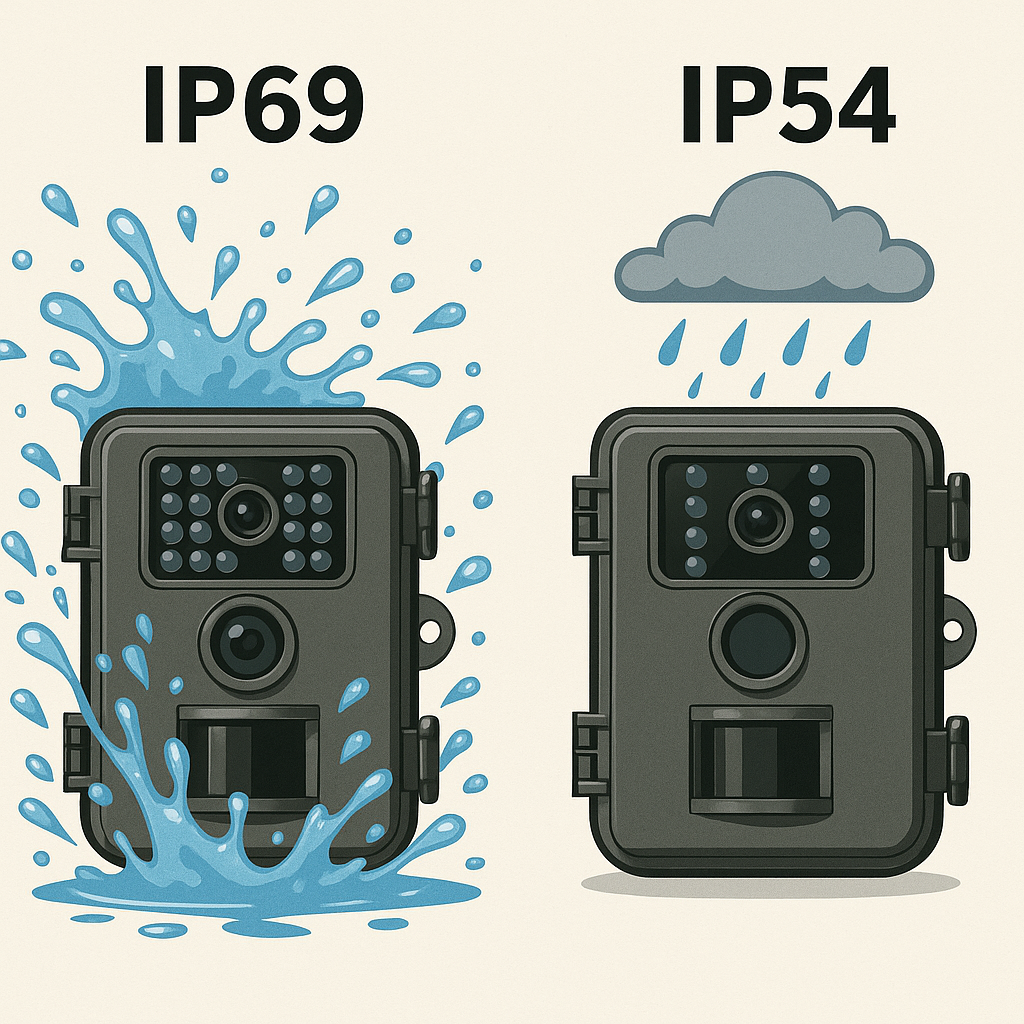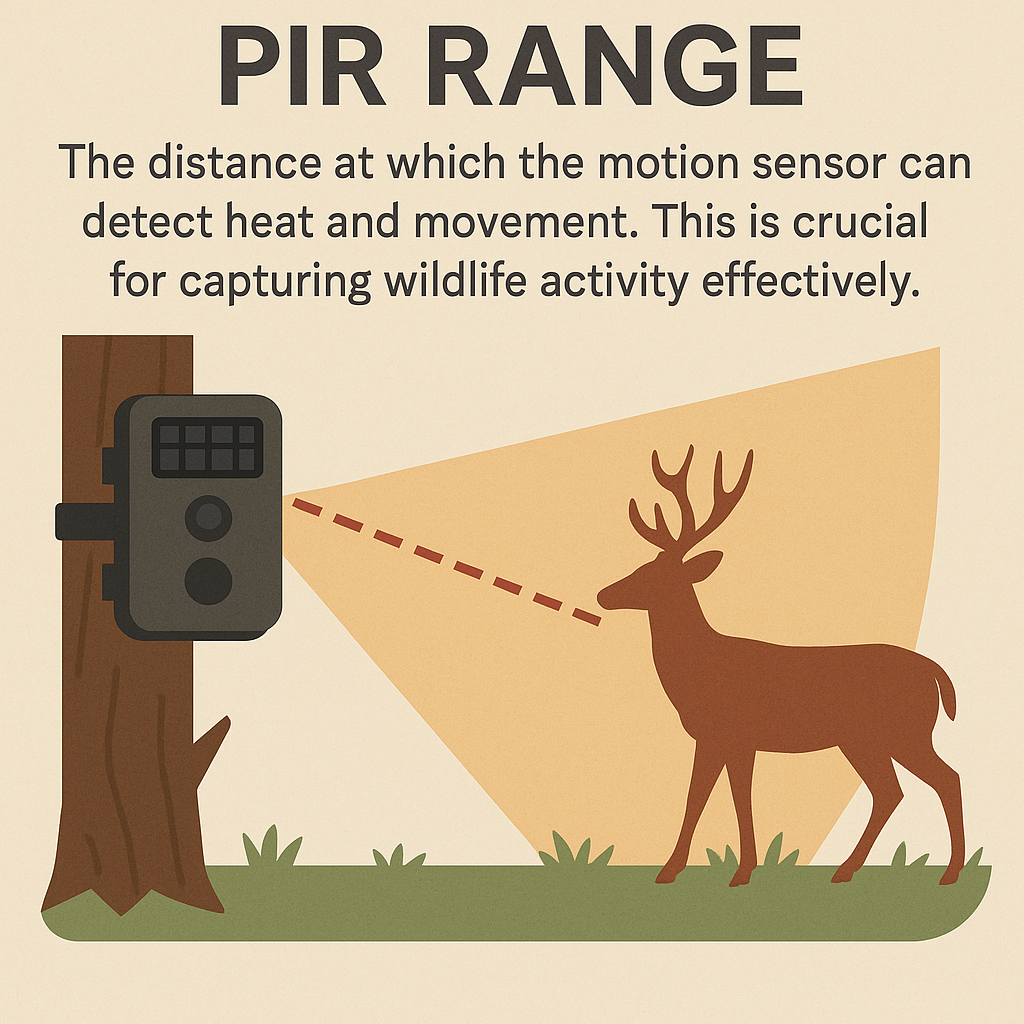Understanding IP Ratings
Dive into the meaning of IP ratings, their significance for trail cameras and electronics, and how they protect against dust, water, and environmental factors.
Choose a trail camera with the right IP rating for your needs and ensure it withstands the weather elements.

| Common Values | Description |
|---|---|
| IP54 | IP54 rating indicates limited dust entry and protection against splashing water. Suitable for mild weather conditions and short-term outdoor use. |
| IP55 | IP55 rating offers limited dust entry and protection against water jets. Ideal for areas with moderate rain and dust exposure. |
| IP65 | IP65 rating provides complete dust protection and resistance to water jets. Suitable for heavy rain and dusty environments. |
| IP66 | IP66 rating ensures complete dust protection and strong water jet resistance. Ideal for harsh weather conditions and open areas. |
| IP67 | IP67 rating indicates complete dust protection and immersion in water up to 1 meter for 30 minutes. Suitable for flood-prone areas. |
| IP68 | IP68 rating provides complete dust protection and immersion in water for extended periods. Ideal for marshes and underwater use. |
| IP69/69K | IP69/69K rating offers complete dust protection and resistance to high-pressure, high-temperature water jets. Mostly used in industrial applications. |
Trail cameras are built to take photos and videos of wildlife, check on remote spots, and keep an eye on places where people don’t go very often. These cameras are usually left outside for weeks or even months at a time, placed in forests, fields, mountains, or at job sites. During that time, they’re exposed to rain, snow, mud, dust, bugs, and big swings in temperature. If a camera isn’t sealed well enough to keep out water or dust, it can stop working, lose all its data, or get damaged for good.
The level of water and dust protection is shown by the camera’s IP (Ingress Protection) rating. Having a good IP rating is key for anyone who wants their trail camera to keep working outdoors. With the right IP rating, your camera keeps snapping clear photos even when the weather gets rough. Knowing what these IP numbers mean helps you pick a camera that won’t let you down.
IP protection, short for Ingress Protection, is an international standard (IEC 60529) that shows how well a device keeps out solid things like dust and liquids like water. The IP rating uses two numbers: the first number is for how well it keeps out solids, and the second is for how well it blocks water.
For example, if a camera has an IP66 rating, the first “6” means it’s totally dustproof, and the second “6” means it can handle strong water jets. Here’s what the numbers mean:
First Digit (Dust/Solid Protection)
Second Digit (Water Protection)
Quick IP Rating Chart for Trail Cameras:
| IP Rating | Dust Protection | Water Protection | Typical Use Case |
|---|---|---|---|
| IP54 | Limited dust entry | Splashing water | Usual outdoor use, gentle weather |
| IP55 | Limited dust entry | Water jets | Lots of rain, general use |
| IP65 | Dust tight | Water jets | Heavy rain, lots of dust |
| IP66 | Dust tight | Strong water jets | Harsh weather, open spots |
| IP67 | Dust tight | Underwater (1m, 30min) | Flood areas, very wet places |
| IP68 | Dust tight | Underwater (long time) | Marshes, underwater use |
| IP69/69K | Dust tight | Very strong water jets | Industrial, extreme places |
Trail cameras are often left out in the open for a long time, facing everything the weather throws at them. If water or dust gets inside, it can cause electrical problems, rust parts inside, or fog up the lens so you miss important photos or videos.
Heavy rain can sneak into an unsealed camera, especially if it’s set low to the ground or at an angle. Snow and ice are also a risk because when they melt, they can leak inside. In dry places, wind can blow dust and sand into the camera, which can jam up the buttons, scratch the lens, or mess with the batteries.
If you’re putting a camera on a mountain, near the ocean, in a swamp, or in the desert, you need high IP protection—usually at least IP66. These places have a lot of water, wind, or dirt, so the camera needs to be sealed tight.
If you’re just using a camera in your yard or garden for a few days, you might be okay with a lower IP rating like IP54 or IP55. But even then, storms can come out of nowhere, so a higher rating is always safer for longer use.
Trail cameras come with a range of IP ratings. Knowing what these numbers mean helps you pick the right one for your situation.
Think about the weather and environment where you’ll put your trail camera. Look at how much rain, snow, dust, or mud you expect. If the area gets storms, strong winds, or is unpredictable, go for a camera with a higher IP rating.
If your camera might be underwater or in pouring rain a lot, you’ll need IP67 or higher. For most wildlife watching or security in normal weather, IP65 or IP66 is usually enough.
Check how well the camera is built. Some models have extra seals, tight latches, and strong cases to keep water and dust out. Look for cameras with tough hinges, doors that fit tightly, and cases made from sturdy materials like polycarbonate or metal.
Maintenance matters, too. Cameras with seals you can replace last longer. Choose models that are easy to clean and have battery compartments you can get into without letting in water or dust.
It’s also smart to read reviews from other users who have used the camera in real life. They can tell you if the camera really stands up to bad weather, not just what the box says.
IP protection keeps trail cameras working in the rain, snow, dust, and mud. The right rating keeps your camera’s electronics safe, your pictures clear, and the camera itself lasting longer. Pick an IP rating that matches where you’re placing the camera—whether that’s your backyard, deep woods, open plains, or a marsh.
Think about your setting, choose cameras with strong IP ratings for tough spots, and follow good placement and maintenance habits. With the right protection, your trail camera will keep capturing great shots and data outdoors, no matter what the weather does.
By paying attention to IP ratings, you make a smarter choice and protect your investment—so your trail camera keeps watching wildlife or your property without fail. Always check the product details, look up user experiences, and pick the water and dust resistance that fits your needs.
Dive into the meaning of IP ratings, their significance for trail cameras and electronics, and how they protect against dust, water, and environmental factors.
Discover the importance and usage of password protection in trail cameras, including setup, benefits, troubleshooting, and best practices to secure your device.
